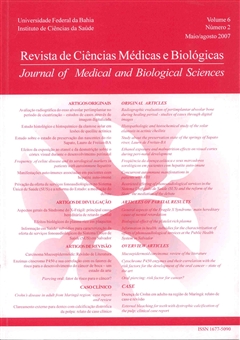Radiographic evaluation of periimplantar alveolar bone during healing period - studies of cases through digital images
DOI:
https://doi.org/10.9771/cmbio.v6i2.4190Keywords:
Osseointegration - Dental implants - Digital images.Abstract
The radiographic evaluation of marginal bone loss around dental implants represents a relevant diagnostic method for osseointegration, despite its limitations. Digital radiographs can provide the same qualitative diagnostic information as conventional radiographs, additionally being able to register quantitative changes in bone density. The aim of this study was to assess gray scale values of areas adjacent to implants during healing period. Pre-implant and post-implant (30, 60, and 120 days after surgery) periapical radiographs were digitized in the DentScan DentView® system. Periapical radiographic images of seven individuals with single surface-treated implants were employed. Results showed a substantial increase of gray values for all the areas assessed in post-implant radiographs 30 days after insertion. Most areas presented a decrease of gray values in radiographs 60 days after implant insertion, and those values tended to increase again 120 days after surgery. It is concluded that gray level measurement represents an acceptable tool to be employed in the radiographic follow up of implant osseointegration during healing period. Further studies with larger samples and a longer follow-up period must be carried out in order to determine osseointegration patterns in dental implantology.Downloads
Download data is not yet available.
Downloads
Published
2007-02-03
How to Cite
Souza, M. C. de, Sampaio, M. D., Torres, M. G. G., Paes, P., Crusoé–Rebello, I., & Campos, P. S. F. (2007). Radiographic evaluation of periimplantar alveolar bone during healing period - studies of cases through digital images. Journal of Medical and Biological Sciences, 6(2), 145–181. https://doi.org/10.9771/cmbio.v6i2.4190
Issue
Section
ORIGINAL ARTICLES
License
The Journal of Medical and Biological Sciences reserves all copyrights of published works, including translations, allowing, however, their subsequent reproduction as transcription, with proper citation of source, through the Creative Commons license. The periodical has free and free access.


